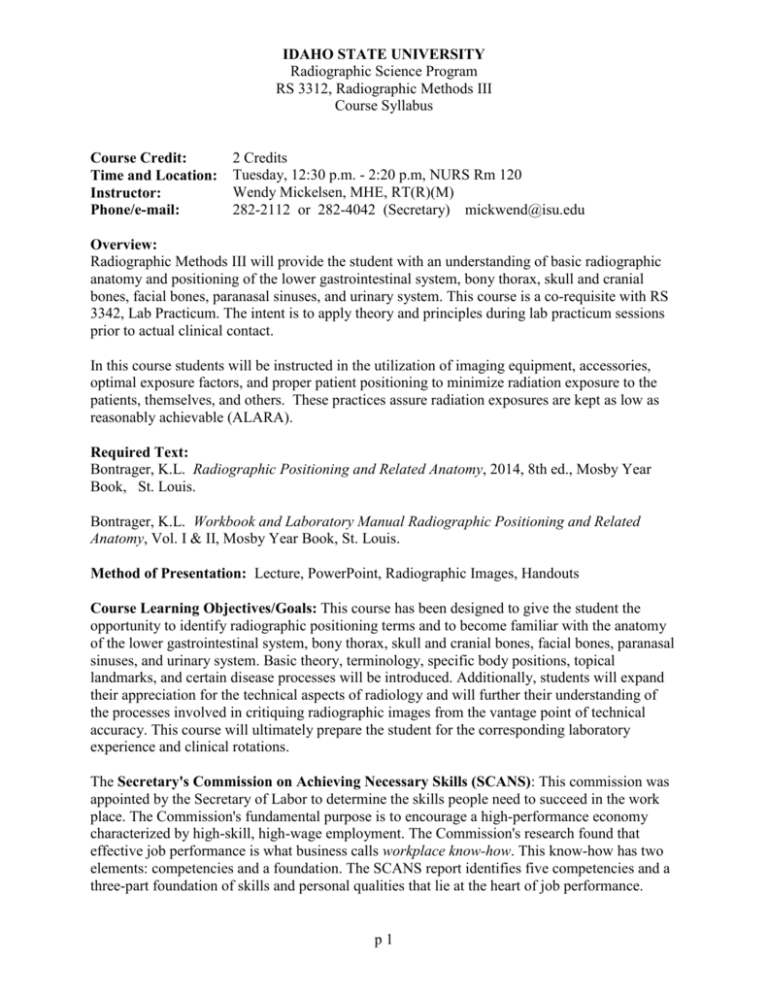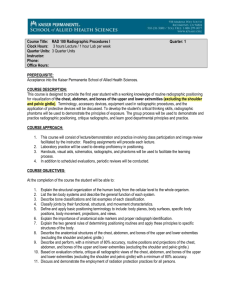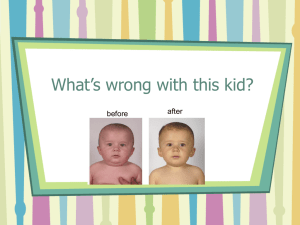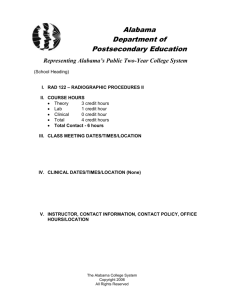Course Syllabus - Idaho State University
advertisement

IDAHO STATE UNIVERSITY Radiographic Science Program RS 3312, Radiographic Methods III Course Syllabus Course Credit: Time and Location: Instructor: Phone/e-mail: 2 Credits Tuesday, 12:30 p.m. - 2:20 p.m, NURS Rm 120 Wendy Mickelsen, MHE, RT(R)(M) 282-2112 or 282-4042 (Secretary) mickwend@isu.edu Overview: Radiographic Methods III will provide the student with an understanding of basic radiographic anatomy and positioning of the lower gastrointestinal system, bony thorax, skull and cranial bones, facial bones, paranasal sinuses, and urinary system. This course is a co-requisite with RS 3342, Lab Practicum. The intent is to apply theory and principles during lab practicum sessions prior to actual clinical contact. In this course students will be instructed in the utilization of imaging equipment, accessories, optimal exposure factors, and proper patient positioning to minimize radiation exposure to the patients, themselves, and others. These practices assure radiation exposures are kept as low as reasonably achievable (ALARA). Required Text: Bontrager, K.L. Radiographic Positioning and Related Anatomy, 2014, 8th ed., Mosby Year Book, St. Louis. Bontrager, K.L. Workbook and Laboratory Manual Radiographic Positioning and Related Anatomy, Vol. I & II, Mosby Year Book, St. Louis. Method of Presentation: Lecture, PowerPoint, Radiographic Images, Handouts Course Learning Objectives/Goals: This course has been designed to give the student the opportunity to identify radiographic positioning terms and to become familiar with the anatomy of the lower gastrointestinal system, bony thorax, skull and cranial bones, facial bones, paranasal sinuses, and urinary system. Basic theory, terminology, specific body positions, topical landmarks, and certain disease processes will be introduced. Additionally, students will expand their appreciation for the technical aspects of radiology and will further their understanding of the processes involved in critiquing radiographic images from the vantage point of technical accuracy. This course will ultimately prepare the student for the corresponding laboratory experience and clinical rotations. The Secretary's Commission on Achieving Necessary Skills (SCANS): This commission was appointed by the Secretary of Labor to determine the skills people need to succeed in the work place. The Commission's fundamental purpose is to encourage a high-performance economy characterized by high-skill, high-wage employment. The Commission's research found that effective job performance is what business calls workplace know-how. This know-how has two elements: competencies and a foundation. The SCANS report identifies five competencies and a three-part foundation of skills and personal qualities that lie at the heart of job performance. p1 IDAHO STATE UNIVERSITY Radiographic Science Program RS 3312, Radiographic Methods III Course Syllabus While the Commission's work ended with the report, its recommendations must be implemented; as the report stated, "...defining competencies and a foundation is not enough. Schools must teach them. Students must learn them." http://www.academicinnovations.com/report.html Description of SCANS competencies are as follows: A Three Part Foundation 1. Basic Skills reads, writes, performs arithmetic and mathematical operations, listens and speaks 2. Thinking Skills thinks creatively, makes decisions, solves problems, visualizes, knows how to learn, and reasons 3. Personal Qualities displays responsibility, self-esteem, sociability, self-management, and integrity and honesty The Five Competencies 4. Resources identifies, organizes, plans and allocates resources 5. Interpersonal works with others 6. Information acquires and uses information 7. Systems understands complex interrelationships 8.Technology works with a variety of technologies Each of these foundations and competencies are listed after the objective that meet the competency or skill set described above. Course Learning Outcomes: Chapter 13 Lower Gastrointestinal System Upon completion of this chapter the student will be able to: On drawings and radiographs, identify specific anatomy as it relates to this chapter. This includes the following anatomy: duodenum, jejunum, ileum, ileocecal valve, cecum, ascending colon, right colic (hepatic) flexure, transverse colon, left colic (splenic) flexure, descending colon, sigmoid colon, rectum, and anal canal. Describe the proper “patient preparation” required for a Small Bowel Series (SBS) and Barium Enema (BE) examination. Determine the correct type of contrast media utilized for exams covered in this chapter and explore Single Contrast vs. Double Contrast procedures. Describe the basic and special projections of the SBS and BE examinations to include CR placement and angulation, correct image receptor size and placement, part positioning, and evaluation criteria. Describe methods the student radiographer can employ to safely work and p2 SCANS 1,2,5,6,8 1,2,4,6 1,2,4,6 1,2,3,4,7,8 1,2,4,5 IDAHO STATE UNIVERSITY Radiographic Science Program RS 3312, Radiographic Methods III Course Syllabus effectively reduce radiation exposure to themselves and their patient when performing fluoroscopy examinations such as SBS or BE. Identify the correct technical factors and/or AEC photo-cell placement for imaging the lower GI system. Demonstrate in a lab setting positioning for each of the exams covered in this chapter. Chapter 10 Bony Thorax Upon completion of this chapter the student will be able to: On drawings, radiographs, and disarticulated bones identify specific anatomy of the bony thorax, sternum, and ribs. Describe and identify the location of the major landmarks of the bony thorax. Describe the differences between true ribs, false ribs, and floating ribs. Describe and identify the anterior and posterior articulations of the bony thorax. Describe the proper application of technical factors when utilizing a breathing technique for an RAO sternum. Describe the “point of interest” technique when performing a rib series. Describe the differences between choosing a 40” or 72” SID when performing a rib series. Identify the correct technical factors and/or AEC photo-cell placement for imaging ribs both above and below the diaphragm. Describe the basic projections of the bony thorax, sternum, and ribs to include CR placement and angulation, correct image receptor size and placement, part positioning, and evaluation criteria. Discuss erect versus recumbent positioning when performing a rib series. Demonstrate in a lab setting positioning for each of the exams covered in this chapter. Chapter 11 Skull and Cranial Bones Upon completion of this chapter the student will be able to: On drawings, radiographs, and disarticulated bones identify specific anatomy of the skull and cranial bones. Identify topographic landmarks and positioning lines of the skull and cranial bones. Identify the coronal, sagittal, squamosal, and lambdoidal sutures. Describe and identify skull morphology classifications (mesocephalic, brachycephalic, and dolichocephalic). Identify, describe, and perform the basic and special projections for the skull and cranial bones including: AP Axial (Towne Method), Lateral, PA Axial (Caldwell Method), PA 0°, SMV, and PA Axial (HaasMethod). Demonstrate correct CR placement and angulation, correct image receptor size and placement, part positioning, and evaluation criteria when performing skull p3 1,2,4,6,7,8 1,2,5 SCANS 1,2,4,6 1,2,6 1,2,4,6 1,2,6 1,2,6 1,2,6 1,2,6 1,2,4,6,7,8 1,2,6,7 1,2,6 1,2,3,4,5,6,7,8 SCANS 1,2,4,6,7 1,2,6 1,2,6 1,2,6 1,2,6,7 1,2,6,7 IDAHO STATE UNIVERSITY Radiographic Science Program RS 3312, Radiographic Methods III Course Syllabus and cranial bone examinations. Describe modifications to the routine examination that are employed when a trauma skull series is performed. Discuss erect versus recumbent positioning for skull and cranial bone examinations. Identify the correct technical factors and/or AEC photo-cell placement for imaging the skull and cranial bones. Discuss and employ radiation safety practices to utilize when imaging the head to reduce the patient dose received to the eye and thyroid areas. Demonstrate in a lab setting positioning for each of the exams covered in this chapter. Chapter 11 Facial Bones and Paranasal Sinuses Upon completion of this chapter the student will be able to: On drawings, radiographs, and disarticulated bones identify specific anatomy of the (14) facial bones and paranasal sinuses. Identify topographic landmarks and positioning lines of the facial bones and paranasal sinuses. Describe, identify, and perform the basic and special projections for the facial bones and paranasal sinuses including: AP Axial (Towne Method), Lateral, PA Axial (Caldwell Method), PA 0°, SMV, Parietoacanthial (Waters Method), Modified Waters Method, Trans-oral Waters Method, Parietoorbital (Rhese Method), Panorex, and axiolateral projections. Demonstrate correct CR placement and angulation, correct image receptor size and placement, part positioning, and evaluation criteria when performing facial bone and paranasal sinus examinations. Describe the osteomeatal complex and the communication of the sinus cavities. Identify when each of the sinus cavities develop. Discuss erect versus recumbent positioning for the facial bones and paranasal sinus examinations. Identify the correct technical factors and/or AEC photo-cell placement for imaging the facial bones and paranasal sinuses. Discuss and employ radiation safety practices to utilize when imaging the head to reduce the patient dose received to the eye and thyroid areas. Demonstrate in a lab setting positioning for each of the exams covered in this chapter. Chapter 14 Urinary System Upon completion of this chapter the student will be able to: On drawings and on radiographs identify specific anatomy as it relates to this chapter. This includes the following anatomy: kidneys, ureters, bladder, urethra. Determine the different types of contrast media employed for procedures p4 1,2,6 1,2,6 1,2,4,6,7,8 1,2,6,7 1,2,3,4,5,6,7,8 SCANS 1,2,6 1,2,6 1,2,6,7 1,2,6,7 1,2,6 1,2,6 1,2,6 1,2,4,6,7,8 1,2,6 1,2,3,4,5,6,7,8 SCANS 1,2,5,6 1,2,4,6 IDAHO STATE UNIVERSITY Radiographic Science Program RS 3312, Radiographic Methods III Course Syllabus covered in this chapter and examine non-ionic vs. ionic contrast media. Identify the basic and special projections for the IVU, retrograde pyelogram, and voiding cystogram. Describe how the student radiographer prepares for urinary procedures including: contrast questionnaire, informed consent form, checking lab values (BUN, creatinine), venipuncture, contrast injection (only to be performed by the supervising technologist). Describe the premedication procedure for a patient that has a known prior allergy to contrast media. Describe and identify symptoms of a patient experiencing a mild reaction, moderate reaction, severe reaction, or organ-specific reaction when administering iodinated contrast media. Describe what is meant by extravasation and the suggested treatment protocol. Describe and identify the need for a fully stocked emergency response cart. Evaluate successful venipuncture in the antecubital fossa by observing a flashback using a butterfly needle. Identify the correct technical factors and/or AEC photo-cell placement for imaging the urinary system. Demonstrate correct CR placement and angulation, correct image receptor size and placement, part positioning, and evaluation criteria when performing urinary system examinations. Demonstrate in a lab setting positioning for each of the exams covered in this chapter. All Chapters (See Lab Syllabi) Concurrently with this course the student will: Participate in radiographic procedures in a lab setting consistent with RS 3342. 1,2,4,5 1,2,3,4,5,6,7,8 1,2,4,6 1,2,6 1,2,6 1,2,6 1,2,4,5,6,7 1,2,4,6,7,8 1,2,6,7 1,2,3,4,5,6,7,8 SCANS 1,2,3,4,5,6,7,8 Code of Ethics: RS 3312 adheres to the ISU Code of Conduct. Academic dishonesty, however small, creates a breach in academic integrity. A student's participation in this course comes with the expectation that his or her work will be completed in full observance of the ISU Code of Student Conduct. Academic Dishonesty Policy: Academic dishonesty (cheating, plagiarism, etc.) will not be tolerated in this class and may result in suspension or dismissal from this course and from the program. Cases will also be referred to the Dean of Students for possible dismissal from the university. Cheating includes, but is not limited to, (1) use of any unauthorized assistance in taking quizzes, tests, or examinations; (2) dependence upon the aid of sources beyond those authorized by the p5 IDAHO STATE UNIVERSITY Radiographic Science Program RS 3312, Radiographic Methods III Course Syllabus instructor in writing papers, preparing reports, solving problems, or completing other assignments; or (3) the acquisition of tests or other academic materials belonging to the university faculty or staff without permission. Plagiarism includes, but is not limited to, the use of, by paraphrase or direct quotation without correct recognition, the published or unpublished works of another person. The use of materials generated by agencies engaged in "selling" term papers is also plagiarism. Many components RS 3312 are designed to be highly interactive. Students are encouraged to take full advantage of the many resources available including Internet sites, handouts and workbooks, other textbooks and journals, faculty, and peers. This interactive collegial learning environment is conducive for life-long learning. Classroom Procedure: 1. Attendance: You are expected to attend class regularly. It is your responsibility to maintain a level of attendance which will allow you to derive maximum benefit from the instruction. Excessive absences (>10%) will result in a lower course grade if you are borderline between two grades. Conversely, if you have good attendance and are border line between two grades, I will award the higher grade. p6 IDAHO STATE UNIVERSITY Radiographic Science Program RS 3312, Radiographic Methods III Course Syllabus 2. Grading Procedure: Assessment Method Test #1 = Chapter 10 Test #2 = Chapter 11 Test #3 = Chapter 13 Test #4 = Chapter 14 Case Study Presentation Final Comprehensive Exam Percentage Value 10% 10% 10% 10% 25% 35% This grading Scale will be used: +/- System 93-100% 90-92% 87-89% 83-86% 80-82% 77-79% A AB+ B BC+ 73-76% 70-72% 67-69% 63-66% 60-62% 59% Below C CD+ D DF Note: A grade of C or better is required in this course in order to receive a degree from the Department of Radiographic Science. The minimum requirements to earn a passing grade are successful completion of all tests (70% minimum). 3. Case Study Presentation: Find an interesting case study and present it to the class Tuesday of ISU’s observed “dead week”. This presentation should take approximately 5-7 minutes. Exams for consideration include any anatomical topic area covered in RS 3312, i.e. lower GI, bony thorax, skull, facial bones, paranasal sinuses, or urinary system. This assignment accounts for 25% of the total grade. Submit the following information in 2-3 typed pages, and obtain permission to provide access to the images for an educational review. All identifiers & patient identification must be removed from any x-rays/medical images used. Items to address include: Clinical history or reason for the examination: Medical imaging examinations ordered: Findings (paraphrase radiologist report): Follow-up if known: p7 IDAHO STATE UNIVERSITY Radiographic Science Program RS 3312, Radiographic Methods III Course Syllabus 4. Computer Account: All students are required to have an ISU student computer account. There is a fee required for this account. Obtain the account at the Computer Center, which is located in the basement of the College of Business Building or in the Rendezvous Lab. 5. Make-up: If you are unable to sit for an examination, you may request a make-up exam. You must inform me that you will not be present for the examination prior to the scheduled time. An additional 10% drop in the test grade will result if prior notification is not given prior to taking the test. The highest grade you can receive for a make-up exam is 89% unless you provide an acceptable excuse. An acceptable excuse is defined as very sick; a death in the immediate family; an extreme extenuating or unforeseen circumstance that would prohibit you from taking the exam. In addition, it is a requirement to take all tests offered during the semester. An incomplete will be issued for the class if a test is not taken. Workbook Assignments: I do not give credit for completion of workbook assignments; however, I encourage students to keep up with the corresponding chapter in the workbook. Routinely, questions are pulled from the workbook for tests. Cell phone policy: Cell phones should not be used in class. They should be place in silent or vibrating mode or turned off. Additionally receiving and retrieving text messages should not occur during class or in labs. Failure to follow this policy will result in a deduction of grade up to 10% at the discretion of the instructor. If you need to communicate to someone outside of the class in an emergency situation please inform the instructor so accommodations to this policy may be made. Disability Services: Students with disabilities who wish to have accommodations provided by the University must self-identify with Disability Services (236-3599) in order to have accommodations provided. Information and applications are available in the Center and may be picked up in person or requested by telephone. The URL is http://www.isu.edu/ada4isu/ p8 IDAHO STATE UNIVERSITY Radiographic Science Program RS 3312, Radiographic Methods III Course Syllabus Tentative Schedule: 8/25/15 Class Overview and Course Introduction, HIPAA Training Review 9/1/15 Chapter 13 Lower Gastrointestinal System 9/8/15 Chapter 13 Lower Gastrointestinal System 9/15/15 Chapter 10 Bony Thorax – Sternum and Ribs (*Exam #1) 9/22/15 Chapter 10 Bony Thorax – Sternum and Ribs 9/29/15 Chapter 11 Skull and Cranial Bones (*Exam # 2) 10/6/15 Chapter 11 Skull and Cranial Bones 10/13/15 Chapter 11 Facial Bones and Paranasal Sinuses 10/20/15 Chapter 11 Facial Bones and Paranasal Sinuses 10/27/15 Chapter 11 Facial Bones and Paranasal Sinuses (*Exam # 3) 11/3/15 Chapter 14 Urinary System 11/10/15 Chapter 14 Urinary System 11/17/15 Chapter 14 Urinary System (*Exam #4) 11/24/15 Thanksgiving Holiday – No Classes 12/1/15 Course Wrap Up/Review for Final Exam w/Oral Lab 12/8/15 Interesting Case Study Presentations – No Lab Sessions, Dead Week 12/15/15 FINAL EXAMINATION 12:30-2:30pm (TUESDAY) p9










